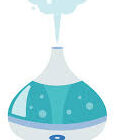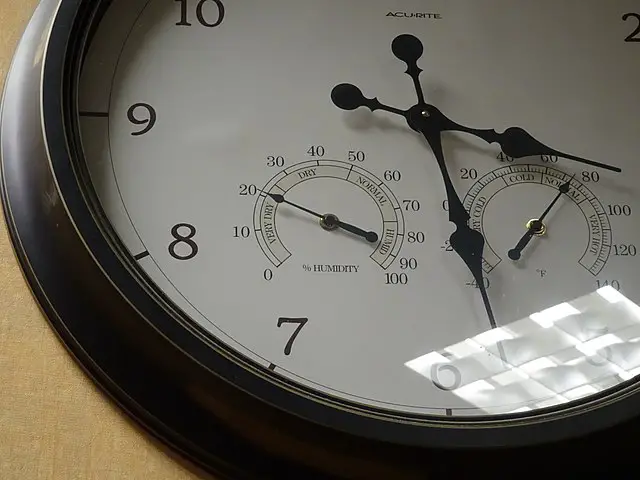Dehumidifier Doesn’t Lower Humidity In Cold Weather: Reasons
There are many reasons why a dehumidifier will not collect water in the winter. First, the air is too cold, and dehumidifiers only work best in 15 to 30 degrees Celsius temperature range. If it is lower than that, it is definitely not going to work well. Secondly, in the winter, the humidity levels drop since cold air does not expand enough to hold moisture. That is why we need a humidifier in the winter more than a dehumidifier.
With the drop in temperature, another change lurks beneath the surface: the humidity levels start to take a dip. While this may seem like a good thing (no more sticky summer air!), it can create problems like dry skin, static electricity, and even wood cracks.
To combat this, many turn to their trusty humidifiers. But not always! You see, while it is generally agreed that humidity goes down in the winter, in places that experience a humid continental climate, you know, like some places in Canada, China, and elsewhere, winters can be very cold and humid!
If you live in a place like London, Singapore, or Thailand, you may need to use a dehumidifier in the winter.
But what happens when, even when plugged in and humming, your dehumidifier stubbornly refuses to collect any water?
We shall find out soon enough!
Why it does not work in the cold season: Main causes
Several factors can hinder your dehumidifier’s water-collecting prowess in winter, most of which boil down to the season’s unique characteristics:
1. Low humidity
Winter air naturally holds less moisture, making it tougher for dehumidifiers to extract sufficient water for collection.
Below 30% relative humidity, most units simply enter “standby” mode, as there’s barely any moisture to remove. They will rise to the occasion again when there is high humidity inside.
2. Chilly temperatures
Dehumidifiers operate best at moderate temperatures (65-80°F). When the mercury dips below this range, especially for refrigerant dehumidifier models, the chilling air can cause coils to freeze, halting the dehumidification process.
3. Bucket is full: check it
A full dehumidifier bucket can trigger an automatic shut-off, preventing further water collection. Ensure it is empty and properly positioned before ruling this one out.
4. Settings problem
If your dehumidifier’s target humidity is set too high (e.g., 50%) for the winter environment, it won’t collect water as the cold weather will already have achieved the desired level. Adjust the setting to a lower humidity level (30-40%) more suitable for the season.
5. Clogged components
Over time, dust and debris can build up on air filters and coils, hindering airflow and reducing efficiency.
Regular cleaning is crucial to maintaining optimal performance. You might even experience a dehumidifier blowing hot air while totally not lowering the humidity level.
6. Internal mechanical issues
Less frequently, malfunctioning sensors, refrigerant leaks, or compressor problems can contribute to a dehumidifier’s dysfunction. You may also need to do some dehumidifier pump troubleshooting.
If troubleshooting steps fail, professional assistance may be needed.
Do you need a dehumidifier in the cold season?
The answer depends on your specific situation. If you’re comfortable with the current humidity levels and haven’t encountered winter-related dryness issues, then using a dehumidifier might not be necessary.
However, if you experience dry skin, static electricity, condensation on the windows, or concerns about black mold growth at home, a humidifier will be beneficial. Just remember to adjust your expectations and settings for the colder season.
Lastly, if you live in Florida, California, Louisiana, or South Carolina, you might need a dehumidifier in winter—well, not all the time, but on some days.
Best temperature for a dehumidifier to operate
For optimal performance, aim to keep the room temperature within the 65-80°F/18-26°C range.
If your home consistently falls below this, consider using a desiccant dehumidifier, which works effectively at lower temperatures, or investing in a dehumidifier with automatic defrost cycles.
If the air is too cold, frost forms on the dehumidifier coils and this prevents the extraction of water.
There is a clear relationship between humidity and temperature, and mostly, lower temperatures lower the capacity of the air to hold moisture.
Why is dehumidifier blowing cold air and not collecting water?
If your dehumidifier is blowing cold air but not collecting water, it could be facing a myriad of problems.
Starting with the simple ones, check whether the coils are frosted. This typically occurs in refrigerant models when the surrounding temperature is too low. Therefore, try warming the room or positioning the unit away from cold drafts.
In some cases, the defrost settings on some models can help thaw the coils and resume proper operation.
Other causes of a dehumidifier failing to collect water include:
- A faulty compressor won’t lower humidity
- A broken fan could also be faulty, depending on the issue. In that case, order a replacement one and install it
- Needs cleaning: Dirty dehumidifier filters, or a dirty unit in general, will hinder proper operation
- The settings are not right. Entering the wrong settings can cause the unit to fail to work properly
Troubleshooting a dehumidifier that doesn’t lower humidity
As we saw in my post on Midea dehumidifier not collecting water, this is a common problem.
Therefore, before rushing to the repair shop, here are some troubleshooting steps you can try:
- Check the bucket: Empty and reposition the water tank as needed.
- Verify the settings: Ensure the target humidity level is appropriate for the winter environment.
- Clean the unit: Clean the air filter and coils following the manufacturer’s instructions.
- Defrost the coils (Refrigerant Models): Use the defrost setting or increase the room temperature.
- Check for leaks: Inspect the unit for any visible signs of refrigerant leaks.
- Consult the dehumidifier user manual: Refer to your dehumidifier’s manual for specific troubleshooting tips.
If these actions don’t resolve the issue, consider seeking professional help from a qualified technician. If the dehumidifier is under warranty, you can email the manufacturer to know the way forward.
Final thoughts
While a dehumidifier’s water-collecting capabilities might appear muted in winter, understanding the reasons behind this change can help you adjust your expectations and troubleshoot any issues.
After all, when you turn on the heating, it is possible to experience high humidity levels. So, from time to time, you might find the need to run the dehumidifier. Just keep an eye on the hygrometer or humidistat, and switch on the unit if need be.
Keep your unit serviced, know how to clean the dehumidifier filters, and keep an eye on the indoor temperature.

